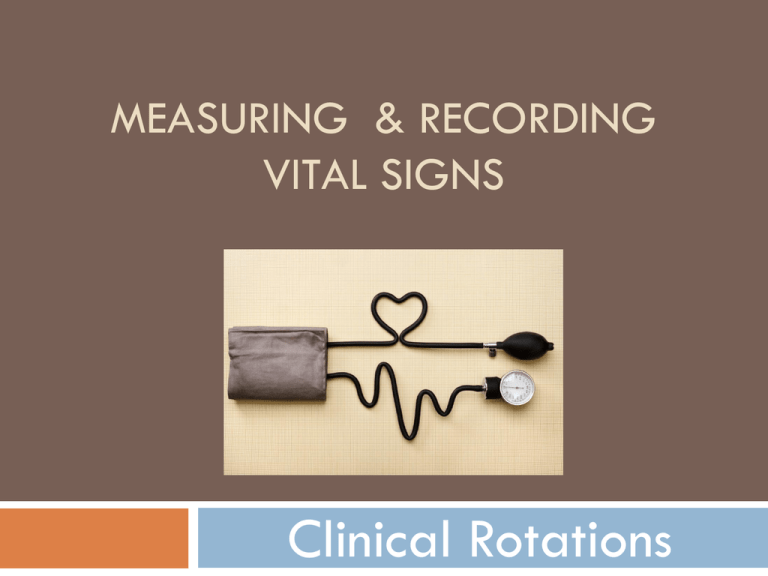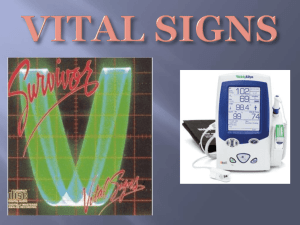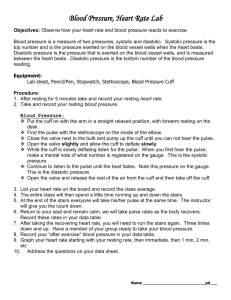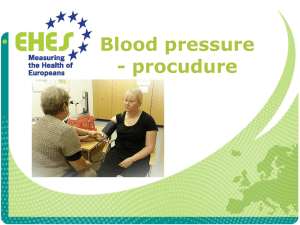Measuring & Recording Vital Signs
advertisement

MEASURING & RECORDING VITAL SIGNS Clinical Rotations The Four Vital Signs Blood Pressure Temperature ----------------------------Pulse----------------------- Respirations Objectives: Students will: List the 4 major vital signs Describe the principles for measuring and recording oral, rectal, axillary, tympanic and temporal temperatures Convert Fahrenheit to Celsius Define- temperature, pulse, respirations, blood pressure and apical pulse WHAT IS BLOOD PRESSURE? When your heart beats, it pumps blood around your body to give it the energy and oxygen it needs As the blood moves, it pushes against the sides of the blood vessels( arteries) – The strength of the force exerted on your vessels is called your blood pressure How is blood pressure it measured? Measured in millimeters of mercury A blood pressure machine is called a sphygmomanometer BP is read at two points: Systolic Diastolic Systolic Blood Pressure Blood pressure Pressure that occurs in the walls of the arteries when the LEFT VENTRICLE OF THE HEART is contracting Normal systolic reading is BELOW 120 mm or mercury Normal range is 100- 120 mm or mercury Systolic is the FIRST sound heard Diastolic Blood Pressure The constant pressure in the walls of the arteries when the LEFT VENTRICLE is at rest (between contractions) Normal diastolic reading is below 80mm or mercury Normal range is 60-80 mm of mercury It is noted as the reading on the BP gauge when the sound STOPS or becomes very FAINT Recording Blood Pressure Recorded in the form of a fraction Systolic is the top number Diastolic is the bottom number Example: 120/70 Pulse Pressure The difference between the SYSTOLIC and the DIASTOLIC pressure Important indicator of the health & tone of the arterial walls Normal pulse pressure is: 30-50 mm of mercury Example: what is the pulse pressure of 110/80 Answer: The pulse pressure of 110/80 is: 30 mm of mercury Abnormal Blood Pressure Pre Hypertension Warning that high blood pressure is likely to develop This condition can harden arteries, dislodge plaque, and block vessels that nourish the heart Indicated by pressure readings of: Systolic –120-139 mm of mercury Diastolic – 80-89 mm or mercury Hypertension Indicated when pressures are greater than 140 mm of mercury COMMOM CAUSES: Stress Anxiety High salt intake Advanced age Thyroid disease Vascular disease such as arteriosclerosis Hypotension Indicated when BP is less than 90 mm of mercury COMMOM CAUSES Occurs with heart failure Dehydration Depression Severe burns Hemorrhage Shock Orthostatic or Postural Hypotension Occurs when there is a sudden drop in BOTH the systolic & diastolic pressures Occurs when an individual moves from a lying to a sitting or to a standing position Blood vessels fail to compensate for the change in position Individual experiences- may last a few seconds Lightheadedness Dizziness Blurred vision Factor affecting BLOOD PRESSURE Heartbeat Condition of the arterial system Elasticity of the arteries Volume of circulating blood Position Factors which may Increase BP Anxiety Nervousness Obesity Stimulant drugs Exercise Smoking Pain Factors which can Decrease BP Sleep Depressant drugs Shock Dehydration Hemorrhage Fasting Sphygmomanometers Aneroid Does not have a mercury column It has a round gauge Each line equals 2 mm of mercury Position at eye level Needle must start at 0 ZERO Electronic Sphygmomanometers Used in most health care facilities Record blood pressure automatically after cuff is placed on patient Will show reading in a digital display Factors to Follow When taking a BP American Heart Association recommends: Patient should be quite for at least 5 minutes Take 2 separate readings Wait at least 30-60 seconds between readings Continued Correct size and placement of the cuff Patient should be sitting or lying down Arm should be freely extended and free of constricting clothes BP cuff must be deflated and free of any air BP cuff should be placed over directly over the brachial artery Edge of cuff should sit 1” above the antecubital space How to take a Blood Pressure Person should be comfortably seated or lying down Should have rested for 10-15 minutes prior to the reading Arms that are paralyzed, injured, have an IV or shunt should not be used**** never take BP the same side as a mastectomy Infant blood pressures can be taken on the leg Blood Pressure Procedure Excess air should be squeezed out of the cuff Cuff should be placed snugly on upper arm. Gauge should be easily visualized Valve should be closed, but easily able to be opened Blood Pressure Procedure Two techniques for obtaining the pressure TECHNIQUE #1 Find radial pulse. Pump cuff till pulse no longer palpated. Then pump another 30 mm Hg higher Place diaphragm of stethoscope on brachial artery about ½ 1 inch above the elbow Release the valve and listen for the two measurements - slowly deflating the cuff. Blood Pressure Procedure TECHNIQUE #2 Find brachial artery and put diaphragm over the site. Pump cuff to 120 mm Hg and listen for the heart beat. If it is heard, pump another 30 mm Hg and listen again. When the pulse is no longer heard, then pump another 30 mm Hg and slowly deflate, listening for the two measurements. Reporting & Recording Reading If reading is uncertain, wait 30 seconds to 1 minute before remeasuring Record the reading and report any abnormalities If the B/P reading is outside of the normal limits, retake it before reporting the value to a supervisor to be certain of accuracy Blood Pressure Skills Lab OBJECTIVE: Successful completion of Skills Check list after demonstrating proficiency in this hands on lab experience 1. Students will have the opportunity to practice taking and recording BP as recommended by the AHA 2. Successful completion of the skills check list is required to pass this skills section of this lesson Temperature Conversions Fahrenheit to Celsius C=(F-32)/ 1.8 Celsius to Fahrenheit F=(C X 1.8) + 32




